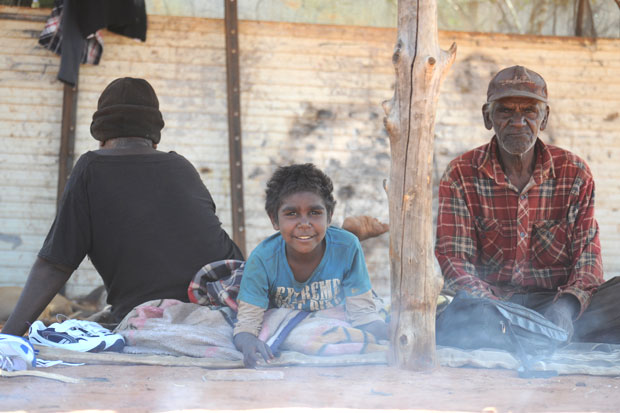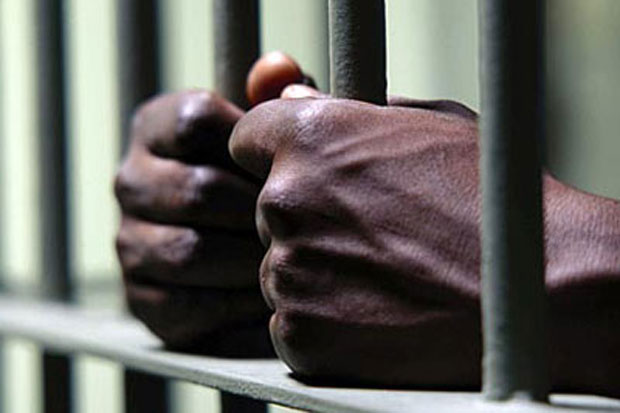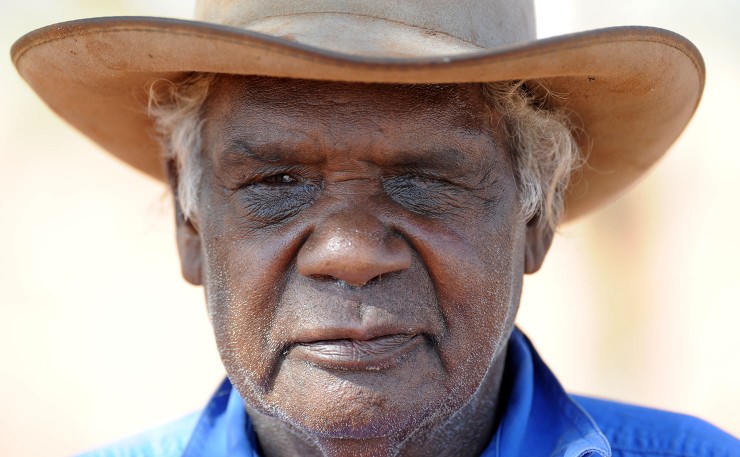When lawyers from the North Australian Aboriginal Justice Agency (NAAJA) come to Darwin Correctional Centre to see an Aboriginal man charged with serious driving offences, they cannot find a way to communicate with him. The man is profoundly deaf, from a remote Aboriginal community, and does not use a sign language they can recognise.
When this man is asked a question, he nods and seems to agree, even though it is not always clear that he understands. He does not seem to understand his charges and at times becomes quite distressed. The lawyers cannot communicate with him enough to enter a plea of guilty or not guilty. He continues to be remanded in prison.
Unfortunately, according to NAAJA, this man’s story is not uncommon. Principal Legal Officer Jonathon Hunyor says that hearing loss is widespread among their clients. A 2010 study of prisons in Darwin and Alice Springs found that 94 per cent of Aboriginal inmates had moderate to severe hearing loss.
This reveals one important link between deafness and the over-representation of Aboriginal people in the criminal justice system.
Aboriginal defendants like this man at Darwin Correctional often begin to lose their hearing as a child, because of repeated ear infections. According to data gathered by Darwin-based psychologist Damien Howard, Aboriginal children are 50 times more likely to contract middle ear infections during infancy than non-Aboriginal children. Most have had their first experience of a burst eardrum by only five and a half months old.
Chronic ear disease (middle ear infections, ‘glue ear’ and ‘runny ear’) is what Howard calls a “disease of poverty”. It is not particular to Aboriginal people, but occurs wherever there is poor nutrition, overcrowded housing, and limited access to medical care. Ear disease was prevalent in poor urban areas like the Fitzroy slums last century.
“It’s common around the world for people in disadvantaged conditions,” he says.
After spending an average of two and half years with ear diseases, an estimated 74 per cent of Aboriginal children go on to develop a permanent hearing loss in adolescence and adulthood. At school, hearing difficulties increase the likelihood of delayed speech, problems learning to read, and isolation from other children.
Samantha Harkus is the Manager of Aboriginal Services at Australian Hearing, and explains that all this contributes to Aboriginal children leaving education early, finding it difficult to find a job, and, ultimately, ending up in trouble with the law.

A typical case is that of a 16-year-old Aboriginal boy from the Northern Territory who was diagnosed with hearing loss during childhood, but did not have access to hearing treatment, speech therapy, or special education. He left school and was convicted shortly after for seven offences including car theft and arson.
“If you have difficulty in schooling you’re more likely to disengage,” says Harkus. “Disengaged kids are more likely to engage in risk-taking behaviour that would bring them into contact with the criminal justice system.”
She says that if hearing loss is not detected early it is more likely to go untreated, because of the difficulty in self-diagnosing hearing loss and the sense of shame attached to it.
If hearing loss does go undetected, the first time it usually becomes an issue is in interactions with police. A common problem that NAAJA encounters is that a deaf offender has misunderstood and reacted incorrectly to a police instruction when they are being stopped or searched.
“Police are often unsure if the person is being uncooperative, or if language is an issue, or if there is a cognitive impairment, and so they often just bulldoze through,” says Hunyor.
If this offender is arrested, their hearing loss is also likely to crop up as an issue during interrogation. Although there are procedures (the Anunga Rules) for respecting the linguistic and cultural differences of Aboriginal people, hearing experts say that they do not think police are generally aware that some of the defendant’s confusion may be down to hearing loss.
“It’s a common problem because in the transcripts of cases that I’ve been involved in, I know there’s a hearing loss before I even see the person,” says Howard. “They’ve either not answered or answered in a way that doesn’t respond to the question.”
These problems are often repeated again in court, especially in noisy and fast-paced criminal trials in the Local and District Courts, where even lawyers like Hunyor admit to sometimes getting lost. In some instances, hearing-impaired defendants will act oddly during court proceedings, speaking too loudly and at the wrong time.
In a 2001 Supreme Court case in NSW, for example, a deaf Aboriginal defendant was removed from the court after alternatively swearing at the judge, singing, sleeping, and threatening the prosecutor. According to his doctor, all this was driven by a mental impairment, hearing loss, and frustration at being “unable to make full sense of [the]proceedings, and… adequately engage in them.”
In the majority of cases, however, the hearing-impaired defendant will appear to withdraw into themselves. This is so prevalent that Howard says that it has become known over time as the ‘Aboriginal demeanour’ in court.
“The most frequent response is to withdraw from the situation, mentally, emotionally, and visually,” Dorothy Parker observed as far back as 1987, in an anthropological study of criminal trials in the Northern Territory. “One magistrate in a country town complained to me that ‘Aborigines in the dock are always gazing out of the window, or looking down and either ignoring questions or mumbling inaudible answers.’”
For lawyers, much of the difficulty is in teasing out whether this disengagement is caused by hearing loss, cultural misunderstanding, or mental impairment. Some of the clients that Hunyor sees at NAAJA have troubles with all three. If a client is found to be profoundly deaf, they are often treated as if they have a mental impairment anyway.
“There’s a whole strand of law and a number of cases which have considered the position of deaf people under the law, and they are actually treated as if they have a mental incapacity, which I think is kind of bizarre, and, for a deaf person, a bit outrageous,” he says.
If a deaf defendant is sent to prison, being unable to hear adds another layer of isolation. Common complaints from prisoners documented in the 2010 Darwin and Alice Springs prison study included; “I can’t hear what my family says”, “I can’t hear them officers and I get in trouble”, “I don’t understand that court fella and I can’t hear what them said”, and “hard for me in prison”.
Harkus, however, points out that these complaints can be remedied so long as the prisoner is tested for hearing loss and given treatment. She tells the story of a 36-year-old female inmate at Mulawa (now Silverwater) Detention Centre who she diagnosed as having severe hearing loss in one ear, and moderate to severe hearing loss in the other.
This woman had entered prison 18 times before this, but this was the first entry in which her hearing had been tested.
Harkus arranged to have her fitted with a hearing aid. As a consequence, the woman was able to talk to her mother over the phone without shouting, and hear what was being said at her weekly Narcotics Anonymous meetings. When she was downgraded to a lower security prison some years later, she became the Aboriginal Women’s Delegate.

“Just providing one hearing aid made a massive difference in what she got out of life,” says Harkus.
However, there is currently no comprehensive hearing screening for Aboriginal defendants at court or Aboriginal inmates entering prison anywhere in Australia.
Australian Hearing has considered pre-trial programs where court support staff would be on hand to test an Aboriginal defendant’s hearing if they or their lawyers requested it. Hunyor says that he thinks that these sorts of programs would be very helpful.
“It would be great where you could go into court and say ‘Your Honour, I’ve got this client in the cells, and I think they might have a hearing issue, could we get that tested?’” he says. “It would be really useful because you have the client there at court.”
Australian Hearing and Justice Health are also considering hearing screening programs in prison reception centres for inmates who have already been registered as having another chronic disease. Hearing services could also be involved in the rehabilitation process.
Howard says that screening defendants and fitting hearing aids is only the start of a solution. He says that police, solicitors, and court officers all need to be trained to better recognise hearing loss and deal with it through visual communication strategies. This might include using pictures and gestures or taking the defendant along to a court before trial so that they can observe what is going on.
“Aboriginal people have very good and astute visual communication strategies, and they watch what’s going on to help understand what is being said,” he says.
However, the big barriers are time and cost. Within the ever-shrinking legal aid budgets of organisations like NAAJA, lawyers like Hunyor have to prioritise suspected disabilities by seriousness, and are usually only alerted to deafness if it is raised in the medical records given to them.
“One of the real shortcomings in the approach that we’re forced to take is that we’re not able to be proactive about a lot of things, and we know that these things contribute to people offending,” he says. The organisation is also in high demand and does not have the time to thoroughly implement visual communication regimes.
“We do what we can to understand and explain, but when you’ve got 30 clients on a bush circuit you don’t really have the time to then say ‘wait outside for five minutes and I’ll talk you through what happened.’”
Howard has found that time and cost is also why governments are not providing more screening, treatment, or visual communication programs. The major governmental response to his lobbying on the issue in 2010 was the Commonwealth transferring the funding responsibility for these services to the States and Territories. He says that because the issue is complex and multi-disciplinary it is easy for government to evade responsibility.
“Police said ‘Oh look, that’s a health issue’, and Health said ‘Oh look, that’s a Justice issue’. It’s a multi-disciplinary problem and so it’s very easily duck-shoved into some else’s basket,” he says.
But, as he points out, concerns about the cost of hearing programs do not make sense if they are compared to the cost of keeping people in prison.
A report released by the Productivity Commission this February estimated the total cost keeping a person in prison at $292 per day.
The issue is also not simply about criminal justice but also about Aboriginal health care more generally. Rates of ear disease seem to be on the rise, and have been recently labelled “a massive public health problem… needing urgent attention” by the World Health Organisation.
“Hearing loss is the missing piece of the puzzle in why Aboriginal disadvantage is so hard to address,” Howard says. “While it remains missing the rest of the picture won’t make sense.”
Donate To New Matilda
New Matilda is a small, independent media outlet. We survive through reader contributions, and never losing a lawsuit. If you got something from this article, giving something back helps us to continue speaking truth to power. Every little bit counts.





